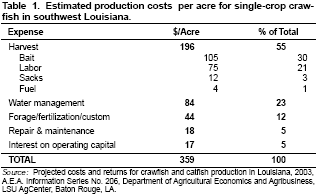
Unlike fishes, crawfish are not harvested
by seining. Instead, crawfish
are harvested with a passive system
that uses baited traps.
Harvest begins as early as mid-
November in the deep South and
continues through April to June. If
fall and winter production of juveniles
is low, and in areas farther
north, harvest seldom begins before
March and often continues into late
July.
Crawfish are harvested frequently
during the season. They may be
harvested from well-managed
ponds 40 to 90 days per year. In the
deep South, two-thirds of the crop is
usually harvested from March
through June when densities of
marketable crawfish are highest and
crawfish are most active.
Trapping is labor intensive and
accounts for more than half of the
total production expense. Bait and
labor are the major costs (Table 1).
Efficient harvesting is essential for
crawfish farming profitability.
Factors influencing crawfish catch and harvest size
The crawfish catch from production
ponds often varies 2- or 3-
fold from day to day (Fig. 1).
Catch is influenced by many factors,
primarily water temperature
and the density of marketable
crawfish. Other factors are water
quality, type and quantity of vegetative
forage, weather, lunar
phase, and crawfish reproduction,
growth and molting patterns.
Table 2 summarizes the major factors
affecting crawfish catch.
Size at harvest is influenced more
by environmental conditions than
by genetics. Crowding reduces
growth and can cause stunting.
Crawfish are aggressive and territorial,
so larger crawfish intimidate
and out-compete smaller
individuals. Crawfish should be
harvested soon after they reach
marketable size. This removes
larger individuals from the population,
reducing aggression and
leaving space and food resources
for undersized animals. The minimum
marketable size for crawfish
varies with season, abundance
and price; however, consumers
prefer a count of 23 individuals
per pound and larger (i.e., 3 1/2
inches and larger). Large crawfish,
10 to 15 count per pound, usually
command premium prices.

Traps
For years, most crawfish traps were
made of 3/4-inch, plastic-coated,
hexagonal mesh wire (poultry
wire), 19 or 20 gauge. This mesh
retained crawfish of minimum
marketable sizeabout 3 inches
and longer (35 count per pound).
Although these traps are still used,
most new traps are made of 3/4-
inch welded square mesh wire. The
square mesh wire is more durable
and retains smaller crawfish, thus
increasing yield. The small crawfish
can be a problem for buyers and
processors, however.
The pyramid trap, with three
entrance funnels, has become the
industry standard (Fig. 2). Optional
cylindrical extensions, usually 6
inches long, can be added to
increase the height of the trap for
use in deeper water. A 6-inch-diameter
plastic pipe (or extruded collar)
is placed at the top of the trap to
function as a handle and to prevent
crawfish from escaping through the
open top. Most traps are made from
24-inch-wide by 44-inch-long or 24-
inch-wide by 54-inch-long wire. The
overall dimensions of traps are
about 17 inches wide at the base
and, with a 6-inch extension, about
26 inches tall.
The inside diameter of entrance funnels
is usually 1 3/4 to 2 inches. Because
wind, waves and avian predators
(herons and egrets) that perch
on the plastic extensions can cause
traps to topple, metal supporting
rods (5/16 inch diameter) are often
added for stability. Crawfish traps
do not have bait protection containers
as do crab or lobster traps
because they reduce the catch.
Baits
Traps must be baited to attract crawfish.
Bait accounts for nearly onethird
of total production cost. The
cost of bait depends on the type
used, amount used per trap, trap
density, and trapping frequency. The
two types of bait used are natural
fish baits and formulated baits.
Fish baits are usually sold frozen in
80-pound or 100-pound boxes.
Clupeid or sardine-like fishes, specifically
gizzard shad and Gulf men-haden or pogy (Fig. 3), are the
most widely used natural baits in
Louisiana where there are commercial
fisheries for both species. They
can be difficult to obtain in commercial
quantities in other southern
states. Herrings, common carp,
suckers, and catfish and buffalofish
heads are also used. Shad, menhaden
and carp attract crawfish better
than other natural fish baits.
Beef pancreas (beef melt), commonly
used by recreational trappers,
is an effective attractant but
too expensive for commercial use.
Formulated crawfish baits, often
referred to as artificial or manufactured
baits, were commercialized
in the early 1980s and are produced
by several feed companies.
These cylindrical pellets contain
mostly cereal grains, grain by-products,
commercial flavoring agents,
and a binder. They are usually 1/2
to 2 inches in diameter and 1 1/2 to
3 inches long (Fig. 3) and are sold in
50-pound bags. Some companies
offer different formulations for use
in cool or warm water.
The availability and price of fish
baits are seasonal and they are more
expensive than formulated baits.
Large farms may have freezers or
coolers for storing bait, but smaller
farms require daily deliveries. The
swimbladder of each fish must be
punctured so it will sink, and it
must be cut into efficient sizes.
This labor adds to the cost. Formulated
baits do not require refrigeration
and are easier to handle.
Further Information
To continue reading this article, please click here (PDF)
Source: Southern Regional Agricultural Center and the Texas Aquaculture Extension Service - Taken from site - January 2006

